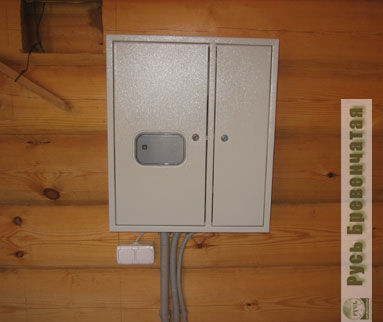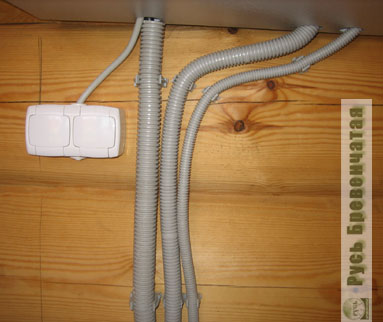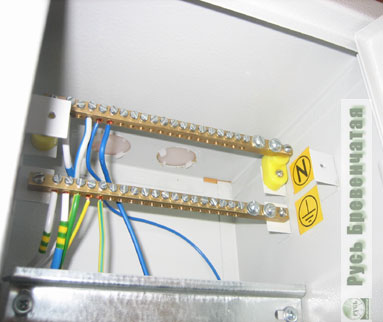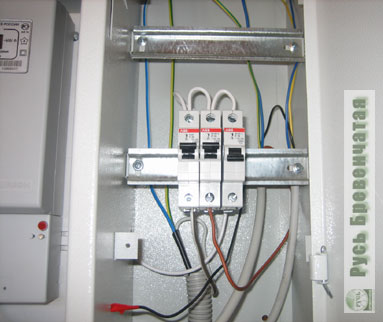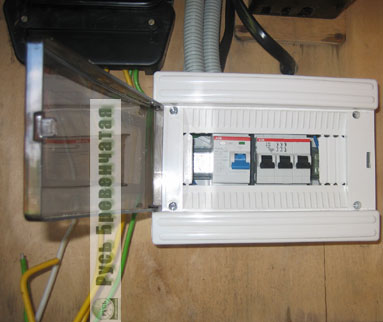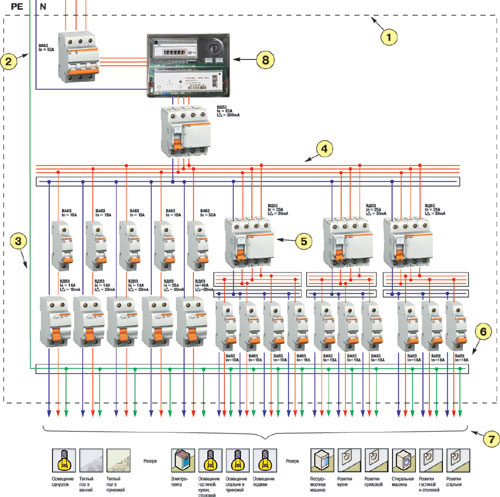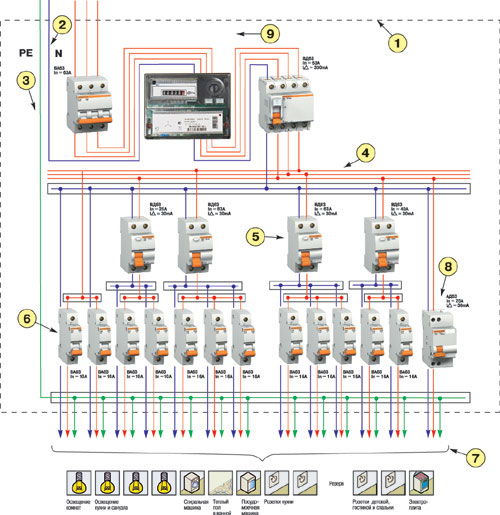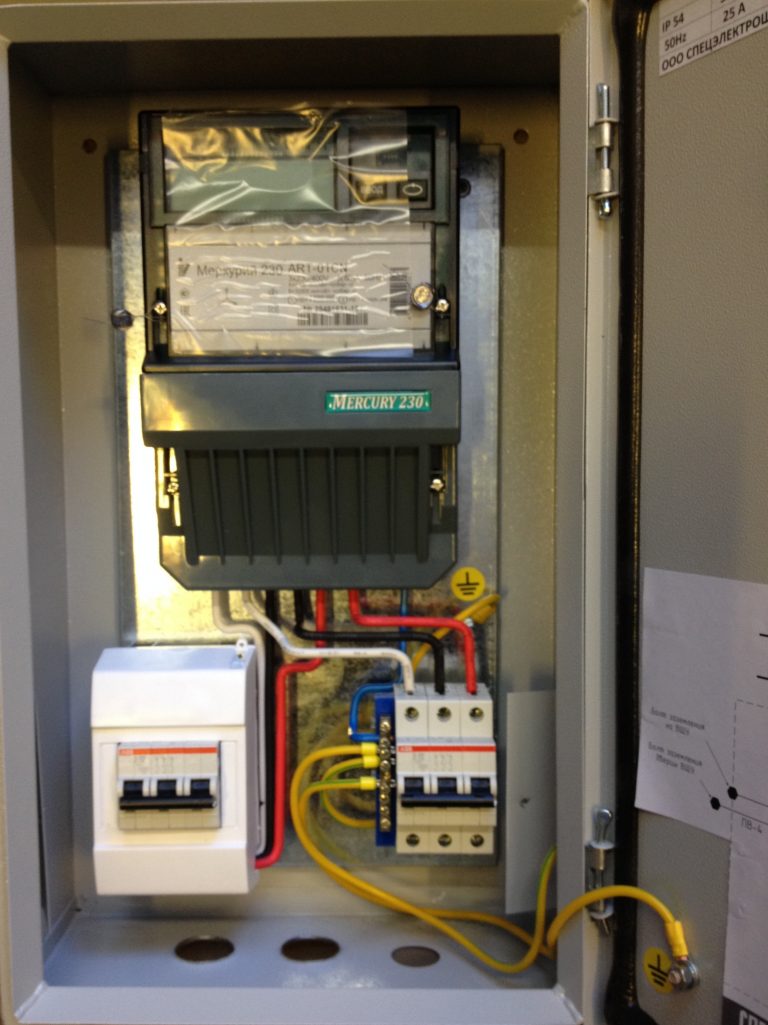
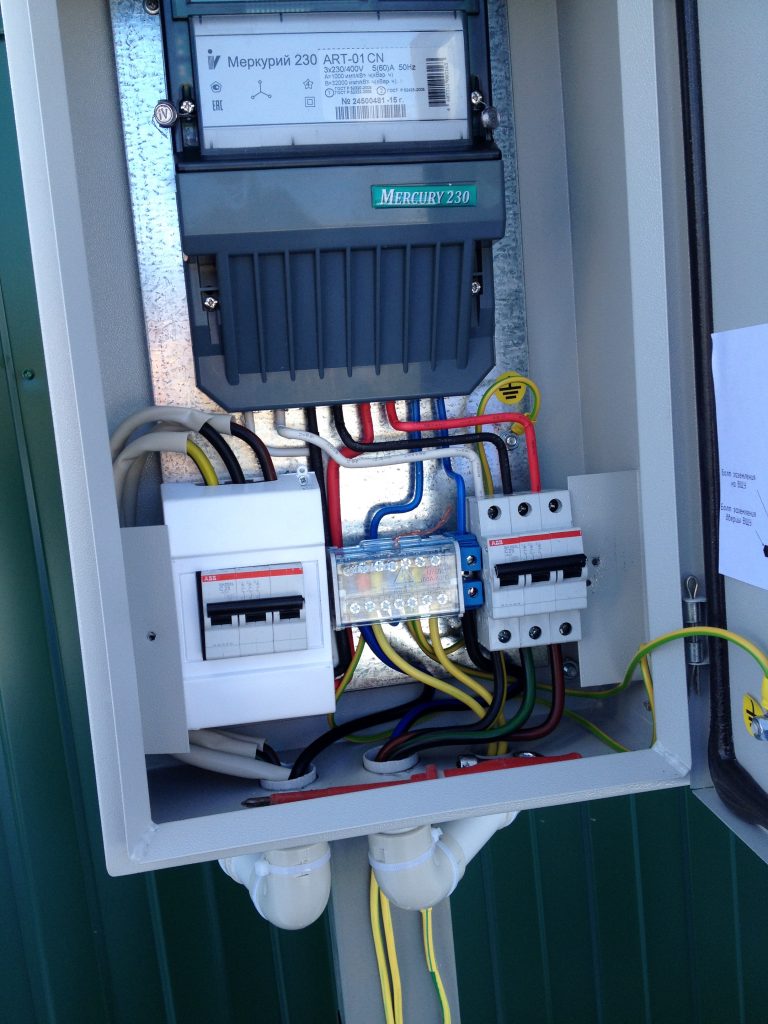
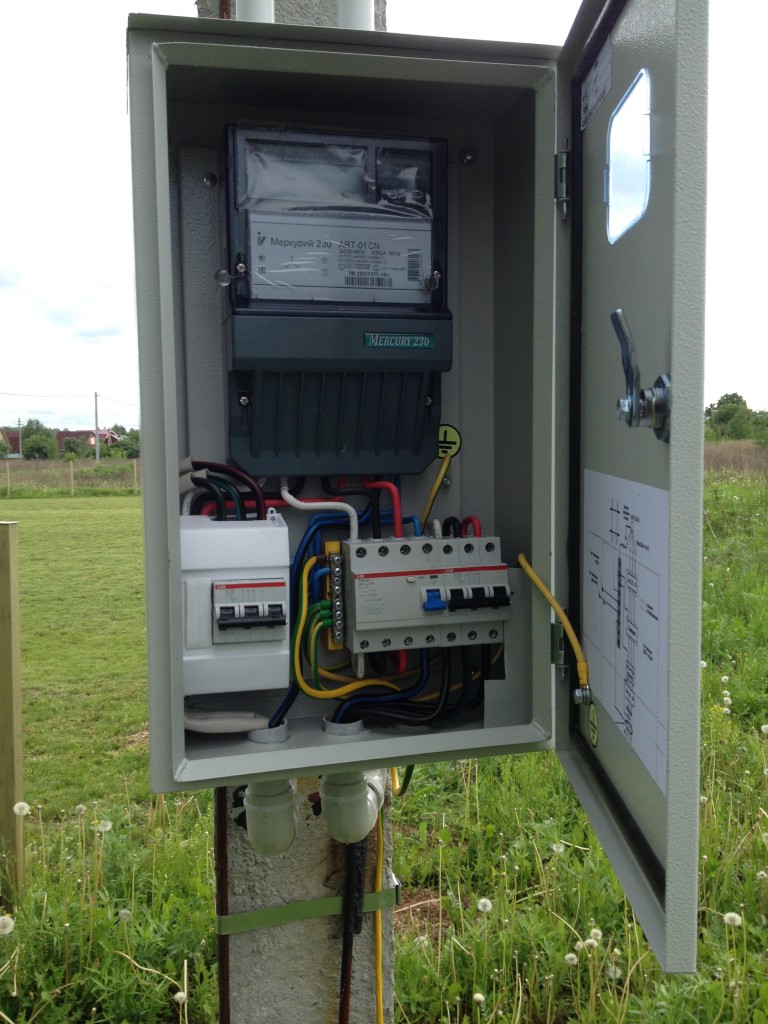
- INTRODUCTION BOARD THREE-PHASE 15 kW 380V, FOR HOME, COTTAGE, COTTAGEhttp: www.e-shkaf.ru
- INTRODUCTION STREET BOARDS are assembled professionally, according to the current rules of PUE, GOST, TU, on components from the best foreign manufacturers, in strict accordance with the requirements of MOESK, MOSENERGOSBYT, RES, ENERGOSBYT.
- In the photo, the introductory electricity metering board Z80 V.
The composition of the input board for metering and distribution of electricity 380 V with RCD on ABB equipment:
1. Three-phase introductory machine, S203 series 3 r 25 A selectivity 6 kA ABB .
2. Electricity meter Mercury - 230 ART-01 CN 5 (60) A 230-400 in a three-phase two-tariff LCD.
3. Introductory RCD ABB series AC 4 R 63 A 300 ma. A FIRE RCD PROTECTS THE INLET CABLE.
4. Automatic series S203 3 r 25 A selectivity 6kA ABB . Second the machine is installed in accordance with the rules of PUE 7.1.24, 7.1.25. IT PROTECTS THE METER FROM OVERLOADS AND SHORT CIRCUIT.
5. Boxing of domestic production ip54 outdoor version with a window, waterproof, for installation on a pole, on a support or pipe stand. Shield with a window, for taking readings from the electric meter and with a visor.
6. Wires Pv1 10.
7. Rexant heat shrink tubes are put on the wires. Does not support combustion. Operating voltage - 600 V.
8. Box for the introductory machine.
9. EARTH BUS Nickel-plated brass against oxidation and external influences for reliable earth connection contacts.
10. DIN rail.
11. BUS ZERO for 7 connections is designed for switching cores of neutral wires and cables. Rated current: 100 A. Made in Italy. Busbar in a transparent casing with a diameter for the corresponding section of suitable wires. Universal tire zero, can be sealed.
INTRODUCTION SHIELD HAS THREE GROUNDINGS.
- 1. Grounding the box door.
- 2.Grounding the mounting plate.
- 3. Chassis grounding.
Inside of the shield on the door we glue the diagram, table, marking of machines and RCDs .
DOCUMENTS FOR MOESK, MOSENERGO, ENERGOSBYT.
1. Passport of the introductory shield, more details on the page PASSPORT OF THE SHIELD VRU 15 KW 380 V.
We want to write to you why exactly these machines and RCDs are installed in the input shield?
TECHNICAL CHARACTERISTICS OF CIRCUIT BREAKERS SERIES S203 MANUFACTURED BY ABB, WHICH ARE INSTALLED IN THE INLET BOARD.
Designed to protect circuits from overloads and short circuits of long cables and electric motors, lighting systems and outlet lines.
The machines of this series belong to premium segment of ABB circuit breakers, are characterized by increased reliability, a wide product range, increased limiting switching capacity compared to other switches.
Application: residential, commercial and industrial facilities.
Compliance: IEC/EN 60898, IEC/EN 60947-2
Icn= 6 kA
Number of poles - 3
Rated current In, A - 25 A
Clamp type: Cylindrical bi-directional terminal block with protection against miswiring, impact resistant
Degree of protection housing - IP4X
clamps - IP2X
The presence of a thermal and electromagnetic release.
Possible versions according to the number of poles
1+N, 3+N with phase conductor releases and neutral disconnection when tripped
1 and 3-pole circuit breakers with releases on each pole.
Includes all possible executions according to the response characteristic
B,C,B,K,Z.
Built-in auxiliary contact in S200 circuit breakers.
Possible, use in conjunction with the DDA-200 prefix, to create protection and overload currents, short circuit and leakage currents.
The devices of the S 203 series are certified in accordance with various international and national standards, which allows their use in almost all countries of the world.
- PUE 7.1.24. VU, ASU must have protection devices (that is, circuit breakers) at all inputs of supply lines (there must be an automatic machine) and on all outgoing lines (there must also be an automatic device).
- PUE 7.1.25. At the input of the supply lines to the VU, ASU, control devices must be installed. On outgoing lines, control devices can be installed either on each line, or be common to several lines.
- The circuit breaker should be considered as a protection and control device.
SPECIFICATIONS UZO 4 R 63 A 300 ma AC series, WHICH IS INSTALLED IN THE INTRODUCTION BOARD.
Voltage, B: 230
Number of poles: 4
Rated differential IΔn mA: 300
Rated current In, A:63
Type of: F204 AC-63/0.3
This device is designed to protect against AC sinusoidal current, its leakage to earth, additional protection with direct (IΔn=30 mA) and indirect contact. The device is capable of disconnecting the electrical supply of circuits alternating current with resistive and inductive loads. Manufactured in accordance with IEC/EN 61008 standards.
When choosing an RCD for a home, the main indicator is the value of the leakage current. Devices with a leakage current of 30 mA protect a person, and an RCD with a leakage current of 300 mA is installed as an input device (for example, at the input to a cottage, house, cottage) and is designed to protect against fire. AC type: (only for alternating current): suitable for protecting installations against sinusoidal leakage current.
Installation of an electrical panel in a private house is a complex process that requires knowledge, skills, and care. This article serves as an algorithm that will help you correctly assemble a shield in a suburban wooden house if you refuse the services of an electrician.
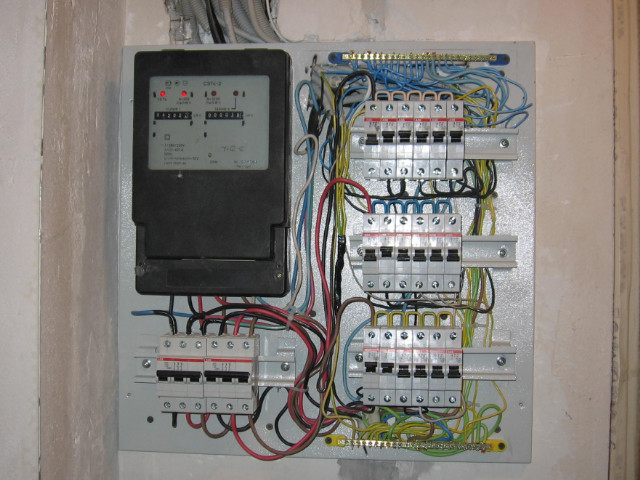
The switchboard receives electricity, distributes it among consumers, protects the electrical circuit from overloads and voltage surges. begin after the replacement of electrical wiring throughout the house is completed, the output of all wires to the place of its attachment. To draw up a shield project, it is necessary to take into account all consumers of electricity:
- sockets (bedrooms, living room, kitchen, corridor, bathroom and toilet rooms);
- light (bedrooms, living room, kitchen, corridor, bathroom and toilet room);
- appliances with high power (boiler, electric stove).
Each group must have its own required automatic machine; for devices with high power, it is necessary to install automatic machines for each device separately. It is better to systematize all data on machines and RCDs in a table.
The standard switchboard layout includes:
- electric meter;
- introductory machine;
- backup machine;
- grounding;
- zero;
- phase;
- tires to zero and ground;
- automatic socket;
- lighting machine;
- electric stove machine.
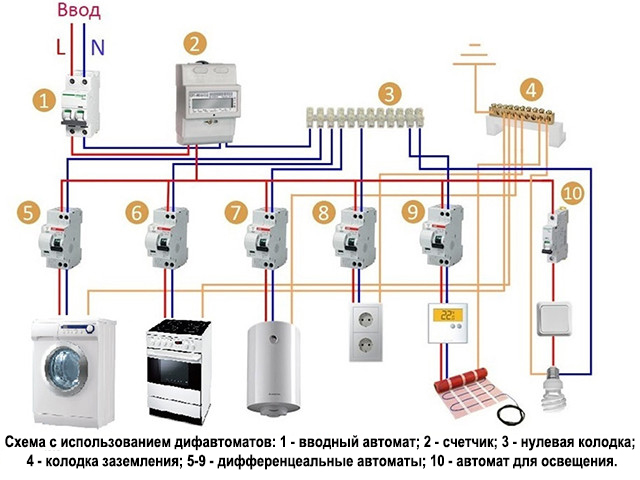
Case - it can be built-in and external. The built-in housing is suitable for connecting the introductory electrical panel in the house. It is installed in a special niche if all wiring is laid internally (hidden). The outer case is installed on the wall if the wiring is laid over the walls, or on the street on a pole from which it comes input cable. In this case, the body is mounted on self-tapping screws. The manufacturer must be verified, the walls were removed, the rails moved back, the shield must comply with safety standards. Cheap housings are made of a material that does not extinguish itself when a fire occurs, and quickly become unusable. A good case should keep a few free slots in case you need to install additional modules.
Modules are selected based on the following parameters:
- current rating;
- shutdown time of the machines;
- the current at which the trip should operate.
Machines must be selected individually for each group: for sockets - 16A, for lighting - 6-10A, for an electric furnace - 25A, for an introductory machine, the total power of all circuits must be taken into account. In case of overvoltage, the automata work alternately from the smallest to the largest. Thus, a balanced system is formed.
The equipment protection device must be more powerful than the machines subordinate to it - this is an important point.
Tires are copper strips into which wires are inserted and fixed with bolts.
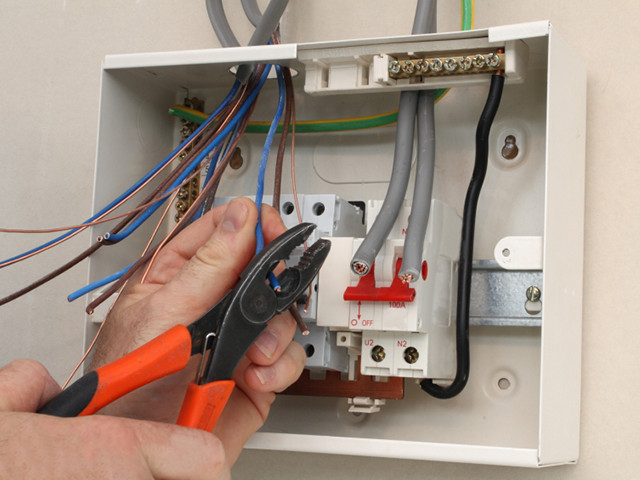
Electrical board assembly
Before assembling the shield, you must completely turn off. The assembly of the electrical panel for a private house is carried out in the following order:
- installation of rails for meters, machines and tires;
- the introductory machine is installed and connected in the top left corner;
- installation of other machines, ouzo, tires to zero and ground;
- phase, zero, ground are connected. Zero - blue wire, phase - red, "ground" - black and yellow. Phases are located at the bottom of the case.
There is a three-phase system in the 380V electrical panel: three phases are connected to the introductory machine, then they go to the meter. Grounding goes from the bus to the sockets. The "earth" of the input cable is connected to the ground bus. Zero is connected either directly to the bus, or passes through the ouzo and then to the bus.
When the installation of the shield in the country is completed, the electrical panel is locked and voltage is applied.
Electrical panel price
The price of the electrical panel consists of the cost of the case itself, all modules, components (wires, bolts, self-tapping screws, insulating paste, light indicators). If you decide to install the shield yourself, then try to buy automation and components of the same series. If you entrusted the contractor to mount the shield, then it is better to entrust the purchase of materials to them. In this case, the price will be increased due to the purchase and installation services.
At the request of our visitors, who are interested not only in the process of making a log house, but also in all further work on the construction of their home, we begin a story about the features of organizing electricians in a country house.
I note right away that specialists should deal with connecting the house to external networks and internal electrical wiring. However, if you have experience with electrical networks, or you just want to know all the intricacies of power supply to country houses, then this material is for you.
Usually cottages are powered from one- or three-phase external networks. Here, as they say, who is lucky. Of course, three-phase networks, as a rule, provide the possibility of obtaining a greater load.
As a rule, entry into the house is through the outer wall from the nearest pillar. The distance should not exceed 20 meters, otherwise the wires will experience heavy loads (from wind, adhering snow, etc.). Often, an automatic switch (machine) is installed at the entrance to the house, which can be turned off in case of an emergency (fire, etc.). From this machine, the cable already goes to the counter. Both the input machine and the counter are sealed by regulatory authorities.
Here is a photo already from the year 2013, far from the time of writing this article. At this point, the construction of the house, including electrical work, is fully completed. You will not see a metal box in the photo electrical panel- it has been replaced by an elegant and compact plastic one. By the way, now the author would lay all external cables (from the stub to the house and from the house to the trailer) with copper cables.
After the counter you can breed internal networks already at your discretion.
The input machine has a set limiting capacity (based on the electrical capacities allocated to you).
The most subtle issue is the organization of grounding and grounding. We are all used to the fact that in sockets and plugs (single-phase networks) we have 3 contacts: phase, zero and earth. It is very good if all these three wires come to your house (with single-phase connection), or 5 wires for three-phase (3 wires of 3 phases, zero and ground).
It's more difficult when you have 2 wires for single phase or 4 wires for three-phase connection(i.e. only the neutral wire goes with the phase(s).
In theory, you should dig a deep hole in your area (to the depth of permanent occurrence ground water) put something metal and massive there and connect this item to the ground contact in your sockets. Unfortunately, this is difficult to implement. And it's not just about unpleasant earthworks, the fact is that this grounding should provide very little resistance, and you will hardly like to water your buried barrel from a watering can every day :)
Fortunately, there is a solution to the problem, since it is up to the authorities providing you with electricity to take care of good grounding. In this case, even if you receive one ground/ground wire (the so-called PEN, you can extract from it PE(i.e. grounding) and N(i.e. neutral or neutral wire).
Of course, this will be somewhat arbitrary, but safe enough. And if you equip your shield with special devices RCD (device protective shutdown) , then you can consider yourself safe, but more on that later.
On the Internet you can find several dozen schemes for connecting houses, but we give in our opinion the three most successful options for connecting to a three-phase network (see the material at the end of the page): two options for separate PE and N inputs, and one combined PEN input. This is the cheapest and therefore the most common option. That's how I connected myself. Note that the order of connection to single-phase network similar.
Pay attention to this last scheme (Option 3 - a copy of the scheme is given below) - at the input we have a wire (green bus) PEN, then it bifurcates. Part goes to the ground bus (remains green), and the second part (turned blue) bypasses the input machine (only phases are important for the machine) goes to the meter and then to the RCD. After leaving the RCD, we already get two completely different tires. If you accidentally short these two wires (i.e. ground and the newly minted zero), your RCD will turn off, signaling a current leakage.
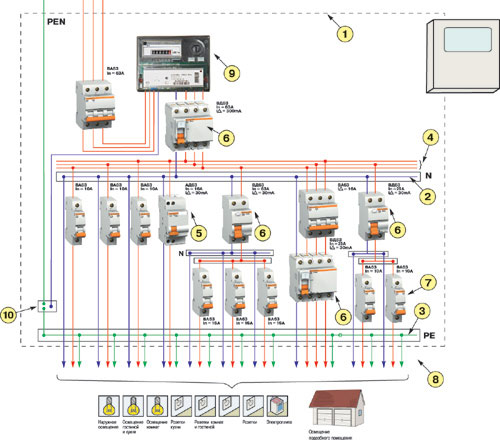
Now let's talk about RCD. Residual current devices have appeared relatively recently, so many people (even experienced specialists) have a wrong idea about their purpose. The main misconception is that if the RCD is designed for 16 amperes, then at 17 amperes it will work. Oddly enough, but it is not. Attention! If you do not have a current leakage, then the RCD WILL NOT WORK if the current exceeds that specified for it! Those. it will not protect your networks from short circuits.
To protect against short circuits, circuit breakers are designed (in common parlance - automata). So what are these RCDs for (by the way, expensive "toys"). So, they are designed to protect a person from current leakage. Who does not remember a washing machine or refrigerator that "bites" when touched. This is what "leakage" is. And if the machines operate at sufficiently significant short-circuit currents, then much lower currents are sufficient for the death / injury of a person (see graph).
Scheme "What does the RCD protect from?"
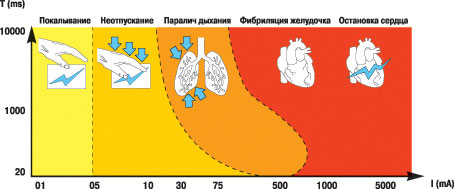
We are grateful to www.domuzo.ru
For the full protection of your networks, you need the combined use of RCDs and automatic machines. Moreover, RCDs are different and differ in the strength of the tripping current (10, 30, 100 and 300 mA). General recommendation next. At the entrance of a cottage or apartment, there should be a so-called "fire RCD" with a trip current of 100 or 300 mA. It is designed to turn off the network in the event of a fire, which is very important for our wooden houses. It is not recommended to install an RCD with currents of 30mA at the input - there will be permanent shutdowns.
So, through an RCD of 300 mA, we tie the entire electrical network in the house. But, through an RCD of 30 mA or 10 mA, we connect those consumers where leakage is possible. First of all, these are premises connected with water (bathroom, toilet, kitchen, boiler room, pumping station, etc.). It does not hurt to bring all the sockets to the RCD - it will not be worse. But it makes no sense to output lighting to the RCD, the probability of electric shock is small, on the contrary, it can only get worse. Imagine, on a dark evening, an RCD in your kitchen is triggered. If at the same time the light goes out, it will only aggravate the situation.
Pay attention to the fact that, unlike automatic machines, neutral wires are also closed to the RCD. But the most important thing is that the neutral wires coming out of different RCDs cannot be connected together - these RCDs will work, signaling a leak.
So how does our RCD work. Very simple. It is a current transformer: two windings, through one flows the incoming RCD current, and through the second - the current passing through the load, i.e. going out. If everything is normal and there was no current leakage "to the side" on the load, then the incoming and outgoing currents are equal and the RCD is operating normally. If a leak occurs (for example, the neutral cable is closed to the body of the washing machine, and you touched it), then part of the current will go through your body and the RCD will work instantly.
But enough theory, let's look at practice. At the time of the original revision of this article (July 2009), I connected the house to the external three-phase network, installed a switchboard, powered a temporary trailer from it, an outlet to the well (for a temporary pump) and the only outlet in the main house. To organize further wiring, it was necessary to install windows and doors (at the moment this has already been practically done,), sand and paint the inner surface of the log house.
|
|
|
The photo above shows a switchboard installed in the house. The supply of external networks is organized underground, which is undoubtedly more convenient and more aesthetic (this requires the consent of the owner of the substation, in this case it was private and the owners of the substation did not build any special obstacles, but rather helped with advice). The connection was made with an aluminum cable in an additional plastic corrugation (left cable, see right photo above). Aluminum was used to save money and make good contact with the wires on the poles (aluminum was also used there). By the way, "nut" clamps were used on the poles for connection, this is much more reliable than ordinary twisting, especially for aluminum.
A note from 2017 - now, of course, I would also make the connection from the pole to the house with a copper wire.
Also aluminum wire wiring was carried out in the trailer (middle cable). All other internal and external wiring has been and will be done with copper cable. NUM and again in a plastic corrugation. The NUM cable is most preferable for organizing internal (especially hidden) wiring, it has 3 levels of insulation, one of which has a self-extinguishing effect (in the event of a fire from a short circuit, etc.).
By the way, the wiring in the house is supposed to be hidden and will be led out of the switchboard into a specially made rectangular channel in the wall of the log house (see top left photo)
The following photos show the internal organization of the switchboard. On the left side there is an electronic two-rate counter(the external network is connected directly to it, without an additional machine - these are the requirements of the owner of the power grids) - this is shown in more detail in the lower right photo.
Let's dwell on the organization of grounding again. Only 4 wires are fed to the entrance of the house (3 phases and the so-called PEN, i.e. combined zero and earth). By the way, the owners of the substation carefully monitor the "good land", especially since the substation undergoes frequent surveys and inspections. They found a very reasonable solution. A zero cable is driven into the bed of a stream flowing nearby with the help of a metal pole.
Once again, pay attention to the connection diagram of Option 3 (see below). The incoming ground/neutral cable (PEN) is brought out to the bottom die (see photo on the left below). This plate is connected to the body of the shield, which will provide protection against electric shock in the event of any leakage. So, already from this die, a blue cable is diverted "Earth", which is now becoming "zero" to the "fire" RCD. From the output of this RCD, the phases are distributed to consumers.
Since only one phase is currently involved, 3 automata are "hung" on it (Fig. Below on the right).
|
|
|
From the left machine, the cable goes into the trailer, where an internal local network is organized with its own shield (photo below on the left).
|
|
In this shield, separately, only through the machine (left of the three), the lighting of the trailer is powered. And the other two machines (designed for sockets) are powered through an RCD with a cut-off current of 30mA (see the leftmost block with a blue switch). This completes the power supply equipment. Please note that when designing the "stuffing" of the switchboard, it must be borne in mind that the RCDs occupy 2 positions in width on the DIN rulers (if the RCD is 3-phase, then 4 positions). Therefore, if you plan to protect several consumers with the help of RCDs, then check if you have enough space in the shield for all RCDs and machines. |
Applications. Schemes of switchboards in country houses
|
|
Option 1. Scheme of a group switchboard of a cottage (PE and N are separate)
1 - Plastic or metal shield body |
|
We are grateful to www.domuzo.ru |
Option 2. Scheme of a group switchboard of an individual building (house or cottage) - (PE and N are separate)
1 - Plastic or metal body of the shield. |
|
We are grateful to www.domuzo.ru |
Option 3. Scheme of a group switchboard for an individual residential building (PEN: i.e. PE and N combined) - adopted by our client An RCD with a differential current of 300 mA is installed at the entrance to the cottage (when installing an RCD with a lower leakage current, false alarms are possible due to the long length of the wiring and the high natural background of electrical equipment leakage). The first three circuit breakers are designed to protect lighting circuits from overload, short circuit and leakage currents. Group of RCDs and three circuit breakers designed to protect outlets. A three-phase circuit breaker and an RCD protect powerful consumers (for example, an electric stove). The last line, consisting of one RCD and two circuit breakers, is designed to protect the circuits of a separate building (for example, a utility room). |
